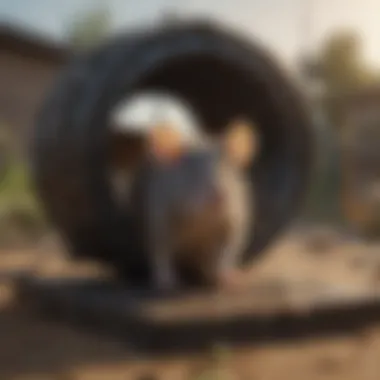Effective Strategies for Baiting Rat Traps


Intro
Managing rat populations is vital for creating a safe and healthy living space. Rats pose various health risks and can damage property. Many homeowners, pest control professionals, and DIY enthusiasts face the challenge of effectively dealing with these pests. Understanding how to use bait strategically in rat traps is key to this effort. This article will delve into the factors that influence bait selection, guide readers through the complexities of rat behavior, and present practical suggestions to enhance the chances of successful trapping.
Identification of Common Pests
Description of Common Pests
Rats are among the most common pests that invade homes. Two main species are prevalent in various regions: the Norway rat and the roof rat. The Norway rat is typically larger, with a stout body and shorter tail. In contrast, the roof rat is more slender and agile, capable of climbing tree branches and entering homes through roofs. Understanding the specific traits of these rats can aid in selecting proper bait and trap placement.
Signs of Infestation
Identifying an infestation early is crucial for effective pest control. Here are common indicators:
- Droppings: Found near food sources or nesting areas, these dark grains indicate recent activity.
- Nests: Rats build nests in secluded areas, often using shredded fabric or insulation.
- Gnaw Marks: Look for chewed wood, wire, or food packaging. These marks are rough and ragged in appearance.
- Unusual Noises: Scratching or scurrying sounds at night may suggest rodent activity.
Being aware of these signs helps in timely intervention.
Effective Bait Selection
Types of Bait
Choosing the right bait is essential for effective trapping. Rats can be picky eaters. Here are some options to consider:
- Peanut Butter: Strong smell and taste; stickiness helps hold it in place.
- Dried Fruits: Raisins or apple slices attract rats with their sweetness.
- Nuts: Sunflower seeds or walnuts are also favored by some species.
- Commercial Baits: Products such as Tomcat or Victor offer specially formulated options for attracting rodents.
Best Practices for Baiting
Placement of bait matters greatly. Here are some best practices:
- Location: Place traps along walls, where rats like to travel.
- Freshness: Use fresh bait regularly to maintain its appeal.
- Quantity: Begin with a limited amount of bait; if it's consumed quickly, increase the amount gradually.
- Testing: Experiment with different bait types to see which is most effective for your local rat population.
"The most effective bait is one that aligns with the feeding habits of the specific rat species present in your area."
Prevention Techniques
Home Maintenance Tips
Preventive measures can substantially reduce the likelihood of an infestation. Here is a list of maintenance tips:
- Seal entry points around windows, doors, and foundations.
- Store food in airtight containers.
- Keep basements and attics clutter-free to limit nesting opportunities.
- Regularly check basements and crawl spaces for signs of rats.
Environmental Modifications
Adjusting the environment can diminish the attractiveness of your home to rats:
- Landscape Maintenance: Trim shrubs and trees to eliminate potential pathways.
- Waste Management: Dispose of garbage properly in sealed bins.
Eco-Friendly Pest Control Options
Natural Pesticides
There are alternatives to chemical solutions for controlling rat populations. Below are some natural options to consider:
- Peppermint Oil: The strong scent can deter rats. Soak cloths or cotton balls in peppermint oil and place them near entry points.
- Boric Acid: Controlled use can be effective in preventing further infestations, but caution is crucial as it can harm pets.
Organic Pest Control Techniques
In addition to natural pesticides, here are some organic methods:


- Essential Oils: Along with peppermint, oils like eucalyptus and tea tree can repel rodents.
- Homemade Traps: Crafting your own traps from everyday materials can be a cost-effective and eco-friendly solution.
Overall, integrating effective bait strategies and preventive methods can create a balanced approach to rat management. By understanding rat behavior and maintaining vigilance, homeowners can tackle this issue with confidence.
Understanding Rodent Behavior
Understanding the behavior of rodents is critical when it comes to effectively managing rat populations. Knowing how rats think and act can greatly influence bait selection and trap placement. Rodents have distinct patterns in their lives, including how they feed, breed, and seek shelter. Awareness of these behaviors helps homeowners and pest control professionals devise strategies that are not just reactive but also proactive.
Rats are instinctively cautious creatures. They often avoid new traps or bait due to their natural wariness. Gaining insights into their life cycle and habits can lead to more effective use of traps and bait strategies that align with the creatures' tendencies.
The Life Cycle of Rats
Rats reproduce quickly. A typical rat can produce around 5 to 10 litters each year, with each litter containing up to 14 pups. The gestation period for rats is approximately 21 to 23 days. This rapid reproduction rate means that even a small infestation can escalate quickly into a larger problem if not managed effectively. Understanding their life cycle is vital since targeting younger or breeding females can significantly reduce rat populations. Young rats begin to mature in about 5 weeks, making it crucial to act swiftly when problems arise.
Feeding Habits
Rats are opportunistic feeders. They will consume a wide variety of foods, including grains, fruits, and meats. Their dietary preferences can change based on the seasons and food availability. For the most effective bait, it’s essential to understand what attracts them specifically in the local environment. Some common food sources for rats include:
- Dry grains such as oats and corn
- Nuts, particularly peanuts and sunflower seeds
- Various types of meat scraps
- Fruits like apples and bananas
Knowing their feeding habits allows for better bait selection, which increases the chances of attracting them to traps.
Common Hiding Spots
Rats tend to hide in areas that provide shelter and safety. Common hiding spots include:
- Basements and attics
- Cluttered areas or piles of debris
- Within walls and between ceilings
It’s crucial to inspect these spots when setting traps. Setting traps near these hiding areas increases the likelihood of capture.
Types of Rat Traps
Understanding the various types of rat traps is essential for effective rodent control. Each trap operates differently and offers distinct benefits and considerations. The choice of trap can depend on multiple factors such as the level of infestation, lifestyle of the household, and personal preferences.
Snap Traps
Snap traps are among the most traditional and widely used methods for catching rats. They operate using a mechanical mechanism that aims to kill the rodent quickly upon triggering. These traps are typically constructed from plastic or wood. One significant advantage is that they can take down large populations when placed in active rodent areas. The quick mechanism minimizes suffering, which is a benefit from an ethical standpoint.
When setting up snap traps, it's important to use the right bait to increase the likelihood of a catch. Positioning the traps near known rat runways, as well as using enough traps in various locations, often leads to better results. Maintenance is straightforward; regular inspection ensures that traps are functional and bait remains fresh.
Electric Traps
Electric traps represent a modern solution in rat control, using a high-voltage shock to kill rodents quickly. Many homeowners appreciate these traps for their ease of use and efficiency. Once a rat enters the trap, it is directly killed by electric current without the mess often associated with traditional traps.
Electric traps often have features such as indicator lights that confirm a catch, making it easy for users to know when the trap needs to be checked. However, they may require batteries or a power source, which can be a consideration for some users. Ensuring they are placed in areas inaccessible to pets and children is critical for safety.
Glue Traps
Glue traps function differently as they do not kill rodents instantly. These traps are coated with a sticky adhesive that captures rats upon contact. While glue traps can be effective, they are often criticized for being inhumane, as captured rodents may suffer before dying.
Glue traps are easy to use and do not require bait, although adding some scent can improve their effectiveness. They can be positioned in corners or along walls where rats are expected to travel. In terms of cleanup, they tend to be less pleasant; monitoring is crucial, as traps must be checked frequently to minimize distress for the captured animal.
Choosing the right rat trap type can greatly impact the success of rodent control efforts. Each trap has its merits and demerits, and understanding them is key to developing an effective bait and trapping strategy.
Choosing Appropriate Bait
Bait selection is a foundational element in the effectiveness of rat traps. Choosing the right type of bait can significantly improve the chances of capturing rodents. An appropriate bait will attract rats due to their preferences, leading to a higher success rate in trapping. This section emphasizes the importance of understanding what attracts rats and how this knowledge influences bait choices for optimal outcomes. By aligning the bait with the natural tendencies of rats, one can ensure more efficient rodent management, which in turn contributes to a healthier living environment.
Understanding Bait Preferences
Rats have particular preferences based on their diet and habitat. Understanding these preferences is critical. Their foraging habits influence the type of food they gravitate towards. For example, in urban environments, rats may lean towards whatever food is available, but in natural settings, they often choose seeds and nuts. Taking the time to learn about the specific bait preferences of local rat populations can make a significant difference in trapping success.
Types of Food Baits


Grains
Grains are a staple in the diet of many rodents, including rats. They find grains like oats, wheat, and corn appealing. One key characteristic of grains is their high carbohydrate content, which provides energy to rats. This makes grains a popular choice in baiting traps. The unique feature of grains is their ability to be used in various forms, such as whole pieces or as flour. Advantages of grains include their wide availability and low cost; however, they may attract non-target animals as well.
Nuts
Nuts are another excellent option for baiting traps. Common choices include peanuts and almonds. The key characteristic of nuts is their high-fat content, which is particularly attractive to rats. Nuts can provide substantial energy, making them an effective choice. The unique feature of nuts is their strong scent, which can draw rats from a distance. While they are advantageous due to their attractiveness, they may be more costly compared to other baits.
Meats
Meat can also be a powerful bait option. Items such as bacon or dried meats are particularly enticing to rats. The main characteristic of meat is its rich protein content, which draws rats in. This high protein level can make meats a favored choice for trap baiting. However, meats can spoil quickly, leading to potential odor issues and contamination, which is a significant disadvantage in some scenarios.
Fruits
Fruits can also work well as bait, with choices like apples or bananas being popular. The sweet flavor of fruits is appealing to rats, which makes them a viable option. Fruits retain moisture, which adds an element of freshness. However, like meats, fruits can spoil, so using them requires prompt attention. Their advantage is the variety they offer, potentially attracting different rat populations.
Non-Food Bait Options
Nest Materials
Nest materials can serve as bait, especially if you want to create a comfortable environment for rats before trapping them. Common options include shredded paper or fabric. A key characteristic of nest materials is their ability to mimic elements rats would seek for nesting. This can often lead to a successful capture. A unique feature is that they can provide insight into what the rats are currently seeking, helping to refine bait strategies. The disadvantage could be a lesser immediate appeal compared to food-based baits.
Scented Attractants
Scented attractants can enhance bait effectiveness. Products infused with scents that appeal to rats, such as peanut butter or vanilla, can draw them closer. The key characteristic of scented attractants is their capability to evoke curiosity and draw rats from afar. They can be particularly advantageous when combined with food or nest materials. The downside is that scents can dissipate quickly, requiring frequent application to maintain their effectiveness.
Optimizing Trap Placement
The placement of traps is a critical factor in the effectiveness of bait strategies. Proper trap placement increases the chances of successful rodent capture. It is essential to understand rodent behavior and common pathways they use in order to position traps effectively. When traps are set in the right locations, bait becomes an attractive target, ultimately enhancing capture rates.
Identifying High Activity Areas
To optimize trap placement, it’s vital to locate areas where rat activity is highest. Rodents often follow specific trails formed by their movements. Look for signs such as droppings, gnaw marks, or shredded materials that indicate frequent rodent activity. Inspect dark corners, around pipes, and behind appliances, as these areas often serve as highways for rats. Noting these high-traffic zones allows you to set traps where they are most likely to encounter the bait.
Setting Traps Along Runways
Once high activity areas are identified, setting traps along these pathways maximizes the likelihood of capture. Rats tend to travel along edges of walls, seeking shelter and avoiding open spaces. Placing traps against walls, within 2-6 inches of the surface, targets these natural travel routes. Additionally, consider the use of multiple traps spaced along these pathways to cover more ground. This strategic positioning increases the chances that bait is encountered. By aligning traps with runways, you mirror the rodents' natural behavior, making bait more effective.
Avoiding Disturbance
After traps are placed, it is crucial to minimize disturbances. Rodents are skittish and can become wary if they sense anything unusual. When setting traps, avoid sudden movements and noise. Do not relocate traps frequently, as consistency allows rats to become accustomed to their presence. Furthermore, keep the area around traps clean and free of unnecessary clutter. Any disturbances can deter them from approaching the bait. Ultimately, a stable and undisturbed trap environment will ensure that bait remains enticing for rodents.
Best Practices for Baiting
Effective baiting is a critical component in rat management strategies. This section explores best practices for baiting rat traps, emphasizing how fundamental the correct application of bait is in enhancing the likelihood of successful rodent capture. Approaching baiting with careful consideration can optimize trap effectiveness and ultimately lead to improved results in pest control.
Proper Bait Amounts
Using the correct amount of bait is essential for several reasons. First, too little bait may not attract rats effectively, leaving traps unused. Conversely, excessive bait can cause rats to become cautious or overfeed, rendering bait ineffective. It is recommended to use a small amount of bait that is enough to entice but not enough to satiate. Placing about a teaspoon of bait typically works for most types of traps.
Bait Freshness and Quality
The quality of bait directly influences its attractiveness. Fresh bait is far more alluring compared to stale or spoiled options. When selecting bait, choose items with strong scents, such as peanut butter or dried fruits, and consider their perishability. Regularly check and replenish bait to maintain its freshness. If bait appears moldy or stale, it's crucial to replace it promptly to avoid deterring rodents.
Monitoring and Replacement
Ongoing monitoring of traps is necessary for effective rat control. Check traps daily to assess if any are triggered. After a trap captures a rat, the bait must be inspected. If the bait remains untouched, it indicates a need for modification, whether that involves changing the bait type or adjusting the placement of the trap. Establishing a schedule for replacing bait, possibly every few days, ensures that traps remain effective over time.
"Regularly monitoring and replacing bait ensures sustainable trapping effectiveness."


When applying best practices for baiting rat traps, it becomes clear that it involves not only what you use as bait but how you use it, ensuring a strategic approach to rodent management. Understanding the nuances of bait can make a substantial difference in the success of home pest control efforts.
Safety Considerations
Understanding safety considerations is vital when dealing with rat traps and bait. Safety is not just about ensuring the traps are effective, but also about protecting those living in the vicinity, especially vulnerable individuals like children and pets. Incorporating safety measures helps to minimize risks associated with pest control activities.
Protecting Children and Pets
The implementation of traps and toxic baits poses a risk to children and pets if proper precautions are not taken. First and foremost, it is essential to choose the right location for placing traps. They should be in areas that are inaccessible to children and animals. Avoid high-traffic zones in the home, such as living rooms and play areas. Rather, focus on isolated locations where rodent activity is high, such as behind appliances or in the attic.
Moreover, it is advisable to use bait stations that are designed to prevent access to non-target species. These can help to prevent curious pets from ingesting harmful substances. Here are a few tips for protecting children and pets during rat control:
- Educate family members about traps and bait, and clearly communicate hazards.
- Regularly check traps to ensure they do not become hazardous.
- Use child- and pet-proof bait stations to contain both the bait and the trap.
- Store traps and bait out of reach when not in use.
Implementing these precautions can significantly reduce the likelihood of unintended consequences from using rat traps.
Handling Caught Rodents
Handling caught rodents safely is another important consideration. While the traps are designed to eliminate rodents, they can pose risks to humans during disposal or inspection. Following proper measures during these processes is essential.
When inspecting traps:
- Always wear gloves. This protects against any potential disease that rodents might carry.
- Use a plastic bag to dispose of the rodent, sealing it carefully to avoid misuse or odor.
- Wash hands thoroughly after handling traps or caught rodents, even if gloves were worn.
If traps are non-lethal and you are looking to release rodents, be mindful of local regulations about releasing wildlife. Moreover, handle the traps carefully to prevent injuries. There are also situations when it might be too dangerous or difficult to handle the rodents yourself. In these cases, consider inviting professionals who are trained in rodent control.
Proper safety measures ensure effective pest control while minimizing risks, making the home safer for everyone.
Ensuring the safety of all household members during rodent management is not optional but essential. By being extensively aware of the implications surrounding bait and traps, you can foster a secure environment while effectively managing rodent presence.
When to Consult Professionals
In dealing with rat infestations, there are crucial moments when homeowners might need to reach out to pest control professionals. Ignoring these situations can lead to worsening problems, and it is important to recognize the signs that point to the necessity of expert intervention. Professional help not only ensures effective management of the situation but also provides peace of mind.
Signs of an Infestation
Recognizing the signs of a rat infestation is vital for prompt action. Homeowners should be vigilant for the following indicators:
- Droppings: Finding rat droppings is a clear sign. They are usually small, dark pellets scattered in areas of high activity.
- Gnaw Marks: Rats have strong teeth and will gnaw on various materials. Look for marks on furniture, walls, or packaging.
- Nests: Rats create nests from materials such as insulation, fabric, or paper. Noticing piles of shredded materials may indicate nesting sites in your home.
- Sounds: Noises during the night, especially scratching or scurrying sounds from within walls or ceilings, can suggest rodent activity.
- Footprints: Tracking in dusty areas can reveal small footprints, especially if you notice tracks near potential entry points.
If you observe multiple signs, it is wise to consult professionals. Their expertise can lead to more effective solutions and prevent further escalation.
Complexity of the Situation
Some infestations present more complications than others. It is essential to evaluate the complexity of the situation before attempting self-management. Consider the following factors:
- Location of Infestation: If rats are inside walls or hard-to-reach areas, getting rid of them without professional help can be difficult.
- Size of the Infestation: A larger population indicates a more challenging scenario. It is likely that DIY methods may not suffice.
- Health Risks: Rats can pose significant health risks. They carry diseases that can affect both humans and pets. Professional help ensures proper handling of these risks.
- Property Damage: Assess any damage caused by rods. Rats can chew through electrical wires or plumbing, resulting in costly repairs. Professionals know how to address these issues effectively.
For situations exhibiting these complexities, professional intervention is typically the best choice.
"Proactive management and timely consultation can prevent small problems from transforming into extensive issues."
Taking action early is crucial. Understanding when to seek help can save time, money, and stress. Professionals bring not only expertise but also tools and techniques that are not available to the average homeowner, ensuring a comprehensive approach to rat control.
The End
Effective bait use is essential for managing rat populations in residential and commercial settings. The bait selected, its placement, and the overall strategy can significantly dictate the success of trapping efforts. When homeowners and pest control professionals understand rat behavior, bait preferences, and best practices, they increase their chances of successful rodent control.
Recap of Key Insights
- Understanding Rat Behavior: Knowledge of the life cycle and feeding habits of rats is crucial. It helps in choosing the right bait.
- Types of Baits: Recognizing that rats are attracted to specific food types such as grains, meats, and fruits allows for a more targeted approach. Non-food bait options also play a role.
- Optimal Trap Placement: Identifying high-activity areas and minimizing disturbances further enhances effectiveness.
- Best Baiting Practices: It is important to use the right amount of fresh bait. Regular monitoring and replacement are essential for maintaining trap efficiency.
- Safety Considerations: Protecting children and pets is critical. Proper bait and trap handling keeps the household safe.
Importance of Proactive Management
Proactive management signifies anticipating and addressing rat infestations before they escalate. This approach not only saves time and money but also promotes a healthier environment. By employing strategic bait usage, individuals can prevent and control rodent populations efficiently. Regular assessments of one's environment and timely interventions can render significant long-term benefits.







